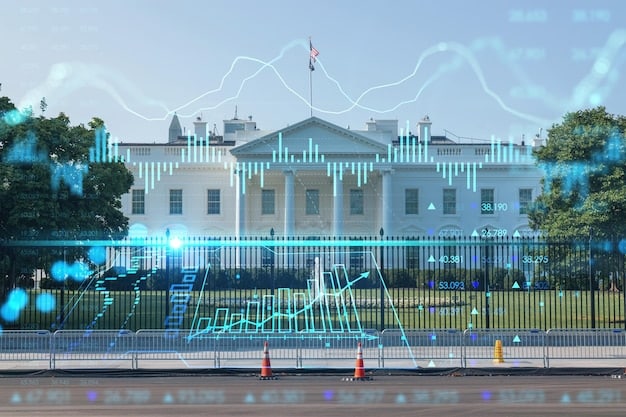2025 Federal Budget: Key Changes & Impact on You

The key changes in the 2025 Federal Budget encompass adjustments to tax policies, healthcare funding, and infrastructure investments, potentially influencing individual finances, business operations, and access to public services across the United States.
Understanding the implications of governmental financial planning is crucial for every citizen. Let’s delve into what are the key changes in the 2025 Federal Budget and how will they affect you, providing clarity on its potential effects on your finances and lifestyle.
Overview of the 2025 Federal Budget
The federal budget is more than just a collection of numbers; it’s a comprehensive plan that outlines how the government intends to allocate resources across various sectors. The 2025 budget is no exception.
Understanding its key components and changes is essential to anticipate its impact.
What’s New in the 2025 Budget?
The 2025 budget introduces several new initiatives and modifications to existing programs. Some key highlights include:
- Increased investment in renewable energy projects.
- Expanded access to affordable healthcare.
- Funding for infrastructure improvements.
- Adjustments to tax brackets and deductions.
These changes reflect the government’s priorities and can have substantial implications for individuals and businesses alike.

The overarching goal of the budget seems to be to foster sustainable economic growth while addressing pressing social issues. The specifics of how this will be achieved require a closer look at the various budget components.
Tax Policy Adjustments
Tax policies are a cornerstone of any federal budget, and the 2025 edition is no different. Here’s a breakdown of the major changes to expect.
These adjustments could shape your tax obligations and potential refunds substantially.
Individual Income Tax Changes
The new budget brings several changes to individual income tax policies. These include:
- Adjustments to income tax brackets to account for inflation.
- Modifications to standard deductions and itemized deductions.
- Potential changes to tax credits for families and individuals.
Business Tax Reforms
Businesses will also experience tax reforms aimed at stimulating economic activity. Key changes include:
These might incentivise investment and job creation.
- Adjustments to corporate tax rates.
- Incentives for small businesses and startups.
- Tax credits for research and development activities.
Healthcare Funding and Initiatives
Healthcare remains a critical priority in the 2025 federal budget. Understanding the funding allocated and planned initiatives is crucial.
These measures can significantly impact access to services.
Expanded Access to Affordable Healthcare
The budget aims to make healthcare more accessible and affordable for all citizens through:
- Increased funding for Medicaid and Medicare.
- Subsidies to reduce health insurance premiums.
- Investments in community health centers.
Mental Health Services
Recognizing the importance of mental health, the budget also allocates funds for:
These measures can improve access to mental healthcare.
- Expansion of mental health services in schools and workplaces.
- Training programs for mental health professionals.

The focus is on preventative care and early intervention to promote overall well-being throughout the population.
Infrastructure Investments and Development
Infrastructure development is vital for economic growth and productivity. The 2025 budget emphasizes several key areas.
Efficient infrastructure is key to economic vitality.
Transportation Infrastructure
The budget allocates significant funds for improving transportation infrastructure, including:
- Modernization of roads and bridges.
- Investments in public transportation systems.
- Expansion of airport capacity and air traffic control systems.
These improvements aim to reduce commute times and improve the efficiency of goods movement.
Renewable Energy Projects
There is also a strong emphasis on promoting renewable energy through:
These investments can drive economic growth in the green sector.
- Incentives for renewable energy production.
- Investments in smart grid infrastructure.
- Support for research and development of new energy technologies.
These measures are intended to promote sustainability and address climate change.
Education and Job Training Programs
Investing in education and job training is essential for developing a skilled workforce. The 2025 budget includes:
These programs can help bridge the skills gap and improve employment.
Enhanced Educational Opportunities
The budget aims to improve educational opportunities for all through:
- Increased funding for early childhood education programs.
- Grants for students pursuing higher education.
- Support for STEM education initiatives.
Workforce Development Initiatives
The budget also focuses on workforce development to equip individuals with the skills needed for the jobs of the future through:
This can help individuals secure better employment opportunities.
- Apprenticeship programs in high-demand industries.
- Skills training programs for unemployed and underemployed individuals.
The focus is on aligning education and training with industry needs.
Defense Spending and National Security
Defense spending remains a significant component of the federal budget. Key allocations include:
- Investments in advanced military technologies.
- Programs to enhance cybersecurity defenses.
- Funding for military readiness and modernization.
These allocations aim to ensure national security amidst global challenges.
Impact on Social Security and Retirement
Changes to Social Security and retirement programs are of primary interest to many Americans. The 2025 budget may introduce:
These revisions have the potential to reshape retirement planning.
- Adjustments to Social Security benefits to account for inflation.
- Potential changes to the retirement age.
- Incentives for private retirement savings.
The goal is to ensure the long-term sustainability of these programs while providing adequate support for retirees.
| Key Point | Brief Description |
|---|---|
| 💰 Tax Policy | Adjustments to income and corporate tax rates. |
| 🏥 Healthcare | Increased funding for Medicaid, Medicare, and mental health services. |
| 🛣️ Infrastructure | Investments in roads, bridges, public transport, and renewable energy. |
| 📚 Education | Grants for students, early childhood education, and STEM initiatives. |
Frequently Asked Questions
▼
The 2025 budget includes adjustments to tax brackets and deductions, which could alter individual tax liabilities. Changes may also impact credits for families and individuals.
▼
Key initiatives include increased Medicaid and Medicare funding, subsidies for health insurance premiums, and investments in community health centers to broaden healthcare access.
▼
The budget allocates funds for roads, bridges, public transport, and renewable energy projects, aiming to reduce commute times and improve goods transportation efficiency.
▼
The budget emphasizes early childhood education, grants for higher education students, and support for STEM initiatives to enhance educational opportunities for all demographics.
▼
The budget may include adjustments to Social Security benefits to account for inflation, possible changes to retirement age, and incentives for private retirement savings.
Conclusion
Understanding the key changes in the 2025 Federal Budget is crucial for all citizens, as its multifaceted impacts on tax policies, healthcare, infrastructure, education, and social security could shape the economic landscape and personal finances of individuals across the United States.





